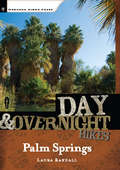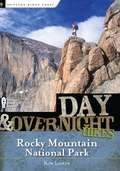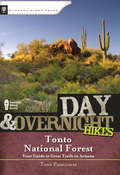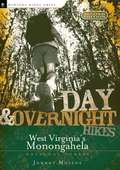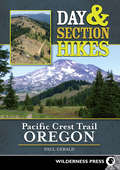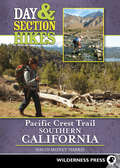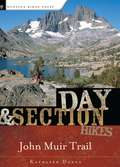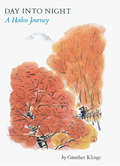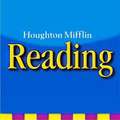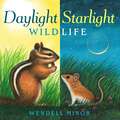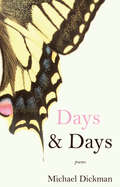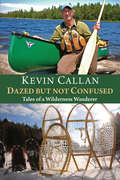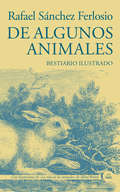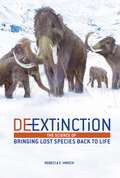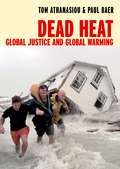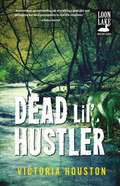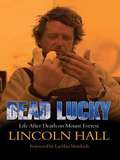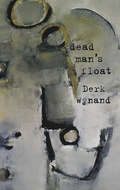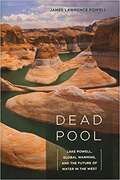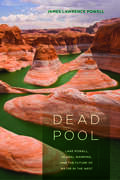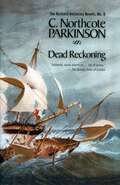- Table View
- List View
Day and Overnight Hikes: Palm Springs
by Laura RandallPalm Springs has long been known by Los Angeles residents for its beautiful hiking trails. With the Joshua Tree National Monument to the east, the San Bernardino National Forest north and south, and the Pacific Crest Trail not far away, this area is rife with wonderful outdoor opportunities. This book collects each of them and offers detailed ratings and maps for use out on the trail, providing an invaluable resource for hikers of all levels.
Day and Overnight Hikes: Rocky Mountain National Park
by Kim LipkerRocky Mountain National Park is the living showcase of the grandeur of the Rockies, with elevations ranging from 8,000 feet in the valleys to 14,259 feet at the top of Longs Peak. Choosing the best day and overnight hikes from the 359 miles of hiking trails and 200 backcountry sites is a major task. First-time, novice, and seasoned hikers hit the trail faster with this practical illustrated guide. Whether looking to watch the elk rut in autumn, the summer blooms on the hillside, the thundering falls in spring, or the white-blanketed calm of the forest in winter, readers can find everything they need here. From Grand Lake in the west to Estes Park in the east, this guide covers the park with original GPS-based trail maps, detailed trail descriptions, overnight camping recommendations, trail guides suitable for different experience levels, and more.
Day and Overnight Hikes: Tonto National Forest
by Tony PadegimasCentral Arizona's most popular forest area houses six separate ecosystems, and much of it can only be seen on foot. Hikers have long known about the natural wonders that exist here, and this guide corrals all of the best hikes - no small task, since there are over 900 miles of trails in the park. Offering detailed descriptions of each hike, along with practical, need-to-know logistical information, this guide demystifies a truly enormous and beautiful stretch of wilderness.
Day and Overnight Hikes: West Virginia's Monongahela National Forest
by Johnny MolloyThe heart and soul of wild, wonderful West Virginia, the mighty Monongahela National Forest is within a day's drive of one-third of the population of the United States. The best way to see and experience the stately forests and pristine waterfalls is by foot. Day and Overnight Hikes: West Virginia's Monongahela National Forest will guide visitors the entire way while exploring this national treasure.
Day and Section Hikes Pacific Crest Trail: Oregon
by Paul GeraldThe Pacific Crest Trail was designated as one of the first National Scenic Trails way back in 1968. As it traverses the "high road" from Mexico to Canada, incredible views are not only commonplace but also uniquely diverse, because the trail connects six of North America's seven eco-zones. The PCT's familiar, well-worn path is a special place for hikers from all walks of life on walks of all lengths and for all reasons.Instead of guiding you through the arduous task of hiking the entire PCT, the goal of this book is to help you plan trips that incorporate hiking on the PCT in Oregon, whether you have just an afternoon to spare or you want to escape for the entire weekend.Carefully edited maps and elevation graphs generated with GPS data collected by the author on the trail will help make your trip a success.This cargo-pocket guide offers author-tested advice to help you make the most of your time away from civilization, however long (or short) that stretch may be.
Day and Section Hikes Pacific Crest Trail: Southern California
by David Money HarrisThe Pacific Crest Trail was designated as one of the first National Scenic Trails way back in 1968. As it traverses the "high road" from Mexico to Canada, incredible views are not only commonplace but also uniquely diverse, because the trail connects six of North America's seven eco-zones. The PCT's familiar, well-worn path is a special place for hikers from all walks of life on walks of all lengths and for all reasons.Instead of guiding you through the arduous task of hiking the entire PCT, the goal of this book is to help you plan trips that incorporate hiking on the PCT in Southern California, whether you have just an afternoon to spare or you want to escape for the entire weekend.Carefully edited maps and elevation graphs generated with GPS data collected by the author on the trail will help make your trip a success.This cargo-pocket guide offers author-tested advice to help you make the most of your time away from civilization, however long (or short) that stretch may be.
Day and Section Hikes: John Muir Trail
by Kathleen DodgeThe John Muir Trail runs a spectacular 211 miles from Yosemite Valley to the foot of Mount Whitney, crossing through Kings Canyon and Sequoia national parks, the Inyo National Forest, and the Devils Postpile National Monument. This guide has descriptions for six day hikes, five overnight hikes, and the entire trail in six sections, and includes transit and lodging information, altitude profiles, a GPS-based trail map, and ratings for scenery, trail condition, difficulty, accessibility for children, and solitude.
Day into Night
by Gunther Klinge Ann AtwoodIn this exquisite volume of haiku, Gunther Klinge takes us on a journey through the days and nights of each of the seasons, beginning with a spring dawn and ending with a winter midnight.
Day into Night
by Gunther Klinge Ann AtwoodIn this exquisite volume of haiku, Gunther Klinge takes us on a journey through the days and nights of each of the seasons, beginning with a spring dawn and ending with a winter midnight.
Day of the Blizzard
by Stephen Gammell Marietta D. MoskinA brave little girl named Katie goes through a lot of trouble to get her mama's brooch back from the pawn shop.
Day of the Tornadoes
by Gary MillerFew things in nature are more powerful than tornadoes. Their winds rage. They can strike without warning. They can destroy everything in their path. Learn about them by reading this book.
Daylight Starlight Wildlife
by Wendell MinorIn amazingly lifelike, luminous paintings, Wendell Minor, one of America’s finest wildlife and landscape painters, reveals the variety of animals that surround us when we are awake and when we are sleeping. Minor’s vivid introduction to diurnal (daytime) and nocturnal (nighttime) creatures invites readers to experience the movements, sounds, colors, and textures of nature. By day a red-tailed hawk soars through sky, and by night a barn owl silently swoops through it. In the daylight a family of fluffy cottontail rabbits hops into a field to forage for food, and under starlight a family of pink-nosed opossums does the same. As day turns to night and night to day, amazing critters large and small come and go. Children will enjoy comparing and contrasting the roaming habits of the wonderful wildlife that surrounds us.
Days & Days: Poems
by Michael DickmanAn exhilarating and far-ranging meditation on days and how we live in them in the twenty-first century, from the award-winning poet.Michael Dickman's intuitive, agile verse captures us in its unusual pulse. Image-driven and shape-driven, the poems of Days & Days touch on parenthood, childhood, local natural habitats, graffiti culture, roses, and romantic love. Dickman considers both the internal and external vistas that open before him in the course of a day, the memories and the immediate quandaries. The long centerpiece poem, "Lakes Rivers Streams," is a reverie that picks up the flotsam of parenting days on its current. Other poems account for hotel days, or days spent watching TV, taking prescription drugs, watching butterflies. Throughout, we feel the dazzling originality of Dickman's awareness; he meets the brutality, banality, and strange beauty of the quotidian with a level gaze, and with an urgent musicality that carries us beyond these lines and pages.
Dazed but Not Confused: Tales of a Wilderness Wanderer
by Kevin Callan James RaffanA collection of adventures (and misadventures) spent travelling in the wilderness. Kevin Callan presents his best adventures – and misadventures – in the wilderness. Entertaining, yet enlightening, the stories are full of enthusiasm and are designed to get people to explore the wilderness on their own, and it’s hoped, be inspired to protect what’s still left. These captured moments of a life spent traveling in secluded areas and promoting their importance to all of us aren’t just for outdoorsy types. The stories relate to a much broader audience: readers who have pondered sleeping under the stars or paddling a canoe across a calm lake or down wild rapids, or even venturing into the winter woods. After reading this book, they’ll want to pack up and go the very next day.
De algunos animales: Bestiario ilustrado
by Rafael Sánchez FerlosioLas bestias que poblaron el universo de Rafael Sánchez Ferlosio se reúnen en De algunos animales, una asombrosa jungla en forma de libro ilustrado. A ningún lector de Ferlosio le pasa inadvertida la mirada tan atenta y respetuosa que dirige a los animales, así como la relativa frecuencia con que éstos aparecen en su obra. Este libro -el último en que Ferlosio se ocupó- reúne, segregados de su contexto original, pecios, artículos, relatos, poemas y fragmentos ensayísticos que tienen a los animales por protagonistas, y constituye, de paso, un particular recorrido por algunos de sus temas y obsesiones principales. Distintos grabados y litografías provenientes de La vida de los animales, la monumental enciclopedia sobre la vida animal escrita por el zoólogo y escritor alemán Alfred Edmund Brehm, acompañan e ilustran los textos de Ferlosio, donde conviven lobos y corderos, roedores y felinos y algún queotro ser imaginario, como el singular Jilguerotauro. La crítica ha dicho...«Rafael Sánchez Ferlosio fue un autor de culto.»Miguel Ángel Villena, Eldiario.es «Si la vida intelectual española ha tenido un clérigo auténtico, sin duda ha sido el maestro Rafael Sánchez Ferlosio.»Jordi Amat, La Vanguardia «Un escritor enorme, a la altura de nuestros clásicos, mejor que mejor.»Fernando Savater, El País «Si se me pidiese un nombre, uno solo, entre los surgidos en la literatura española de posguerra, con categoría suficiente para afrontar la inmortalidad literaria, yo daría, sin vacilar, el de Rafael Sánchez Ferlosio.»Miguel Delibes «Entre los autores de mi generación o de las anteriores, sólo me interesa Ferlosio, que es el mejor escritor español.»Juan Benet «Todo en Rafael Sánchez Ferlosio tiene una referencia literaria y poética, trate de lo que trate.»Félix de Azúa
De-Extinction: The Science of Bringing Lost Species Back to Life
by Rebecca E. HirschIn the twenty-first century, because of climate change and other human activities, many animal species have become extinct, and many others are at risk of extinction. Once they are gone, we cannot bring them back—or can we? With techniques such as cloning, scientists want to reverse extinction and return lost species to the wild. Some scientists want to create clones of recently extinct animals, while others want to make new hybrid animals. Many people are opposed to de-extinction. Some critics say that the work diverts attention from efforts to save species that are endangered. Others say that de-extinction amounts to scientists "playing God." Explore the pros and cons of de-extinction and the cutting-edge science that makes it possible.
Dead Heat: Global Justice and Global Warming (Open Media Series)
by Paul Baer Tom AthanasiouToday's "extreme weather events" (record-breaking heat waves, droughts, and melting ice caps) foreshadow an increasingly unstable and dire future. Yet, despite all, the US government continues to reject the Kyoto Protocol, to deny the catastrophic consequences of oil dependency, and to define the politics of oil as the politics of U.S. unilateralism, domination, and war.Dead Heat argues that justice--not rhetoric and "aid" but real developmental justice for the people of developing world--is going to be necessary, and surprisingly soon. It argues, more particularly, that such a justice must involve a phased transition from the Kyoto Protocol to a new climate treaty based on equal human rights to emit greenhouse pollutants. Dead Heat makes the case for climate justice, but insists that justice and equity, for all their manifold ethical and humanitarian attractions, must also be seen as the most "realistic" of virtues. It insists, in other words, that our limited environmental space will itself show that it is the dream of a "business as usual" future that is naïve and utopian.
Dead Lil' Hustler (Loon Lake Fishing Mystery #14)
by Victoria HoustonIt's mid-July in Loon Lake, and Police Chief Lewellyn Ferris has her hands full with the discovery of the skeletal remains of a missing bank executive and the murder of a graduate student. To complicate matters, both victims were discovered on a hidden river deep in the national forest--a place that just so happens to be a dangerous wolf rendezvous site. Lew recruits her close friend and fellow flyfisherman, retired dentist "Doc" Osborne for his forensic and interrogation skills. But Doc has his own set of problems to worry about: his grandson is hospitalized with a grave illness, and now Lew seems to be getting too interested in the father of the murdered student--a well-to-do widower who is teaching her the Japanese art of tenkara flyfishing.
Dead Lucky: Life After Death on Mount Everest
by Lincoln HallLincoln Hall's breathtaking account of surviving a night in Everest's "death zone."Lincoln Hall likes to say that on the evening of May 25, 2006, he died on Everest. Indeed, Hall attempted to climb the mountain during a deadly season in which eleven people perished. And he was, in fact, pronounced dead, after collapsing from altitude sickness. Two Sherpas spent hours trying to revive him, but as darkness fell, word came via radio from the expedition's leader that they should descend in order to save themselves. The news of Hall's death traveled rapidly from mountaineering websites to news media around the world, and ultimately to his family back in Australia. Early the next morning, however, an American guide, climbing with two clients and a Sherpa, was startled to find Hall sitting cross-legged on a sharp crest of the summit ridge. In this page-turning account of survival against all odds, Hall chronicles in fascinating detail the days and nights that led up to his fateful night in Mount Everest's "death zone." His story is all the more miraculous given his climbing history. Hall had been part of Australia's first attempt to reach the top of Everest in 1984 but had not done any major climbing for many years, having set aside his passion in order to support his family. While others in the team achieved their dream during this 1984 expedition, Hall was forced to turn back due to illness. Thus, his triumph in reaching the summit at the age of fifty is a story unto itself. So, too, is Hall's description of his family's experience back in Australia, as sudden grief turned to relief and joy in a matter of hours. Rarely has there been such a thrilling narrative of one man's encounter with the world's tallest mountain.
Dead Man's Float
by Derk WynandDead Man's Float details that sad emblem of Western alienation, the tourist couple in their rented tropical Eden. Here life is temporary and not at all cheap. The wildlife is spectacular, the culture incomprehensible, and the locals politely try to hide their hilarity at Canadian pidgin Spanish. Heat, beaches, ruins -- why did we think they could distract us from domestic squabbling or the 3 a.m. dreads? Derk Wynand wrings wry existential meditations from firsthand experience of the Exotic -- the First World and the Third in their ritual winter dance.
Dead Pool: Lake Powell, Global Warming, And The Future Of Water In The West
by James Lawrence PowellWhere will the water come from to sustain the great desert cities of Las Vegas, Los Angeles, and Phoenix? In a provocative exploration of the past, present, and future of water in the West, James Lawrence Powell begins at Lake Powell, the vast reservoir that has become an emblem of this story. At present, Lake Powell is less than half full. Bathtub rings ten stories tall encircle its blue water; boat ramps and marinas lie stranded and useless. To refill it would require surplus water―but there is no surplus: burgeoning populations and thirsty crops consume every drop of the Colorado River. Add to this picture the looming effects of global warming and drought, and the scenario becomes bleaker still. Dead Pool, featuring rarely seen historical photographs, explains why America built the dam that made Lake Powell and others like it and then allowed its citizens to become dependent on their benefits, which were always temporary. Writing for a wide audience, Powell shows us exactly why an urgent threat during the first half of the twenty-first century will come not from the rising of the seas but from the falling of the reservoirs.
Dead Pool: Lake Powell, Global Warming, and the Future of Water in the West
by James Lawrence PowellWhere will the water come from to sustain the great desert cities of Las Vegas, Los Angeles, and Phoenix? In a provocative exploration of the past, present, and future of water in the West, James Lawrence Powell begins at Lake Powell, the vast reservoir that has become an emblem of this story. At present, Lake Powell is less than half full. Bathtub rings ten stories tall encircle its blue water; boat ramps and marinas lie stranded and useless. To refill it would require surplus water—but there is no surplus: burgeoning populations and thirsty crops consume every drop of the Colorado River. Add to this picture the looming effects of global warming and drought, and the scenario becomes bleaker still. Dead Pool, featuring rarely seen historical photographs, explains why America built the dam that made Lake Powell and others like it and then allowed its citizens to become dependent on their benefits, which were always temporary. Writing for a wide audience, Powell shows us exactly why an urgent threat during the first half of the twenty-first century will come not from the rising of the seas but from the falling of the reservoirs.
Dead Reckoning
by C. Northcote ParkinsonIn this final book in the Richard Delancey series, Captain Richard Delancey heads for the East Indies on the 32-gun frigate Laura to take part in the capture of the Cape of Good Hope. His ingenious tactics gain the attention of his superiors, who recruit him for a high-stakes mission: to seek out and destroy the French privateer Subtile.
Dead Reckoning: Learning from Accidents in the Outdoors
by Emma WalkerIt's easier to stay alive if you know what's out there. That's the philosophy behind Dead Reckoning, an honest, unflinching, sometimes-thrilling collection of close calls and catastrophes in the Great Outdoors. Emma Walker's narrative nonfiction covers outdoor activities ranging from hiking to sea kayaking to backcountry skiing, all in accessible, easy-to-understand terms. At the end of each chapter, she distills lessons learned for staying safe in the outdoors––all with a relatable (and occasionally vulnerable) twist.
Dead Snails Leave No Trails, Revised: Natural Pest Control for Home and Garden
by Loren Nancarrow Janet Hogan TaylorA practical guide to repelling indoor and outdoor pests using organic methods, updated with new information on getting rid of bedbugs and dust mites, plus includes updated online resources. If you've ever had a swarm of fruit flies in your kitchen or a gopher wreaking havoc in your yard, you may have wondered what a conscientious gardener or homeowner can do short of heavy-duty chemical warfare. Dead Snails Leave No Trails is a comprehensive guide to repelling both indoor and outdoor pests using organic methods--it's the perfect DIY solution to eliminate unwelcome visitors in your home and garden while keeping yourself,your family, and the environment safe from harmful chemicals.With a few easy-to-find items, you'll learn how to: * Make your own all-purpose pest repellents with simple ingredients like chile peppers and vinegar * Use companion planting to attract beneficial insects and animals or repel harmful ones * Keep four-legged intruders--including squirrels, deer, rabbits, and skunks--away from your prized vegetables and flowers * Safely eliminate ants, roaches, and rodents from your house or apartment * Protect your pets from critters like ticks and fleas This revised edition contains newly updated information on today's pest epidemics, like bedbugs, as well as new online resources for finding beneficial organisms that act as predators for specific pests. Full of tips, tricks, and straightforward instructions, Dead Snails Leave No Trails is the most user-friendly guide to indoor and outdoor natural pest solutions.
